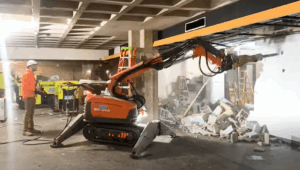Softstripcontractors.co.uk (operated by W & S Hire Ltd) is already known for being a leading soft strip demolition contractor in the UK. They specialise in removing non‑structural interior elements — ceilings, fixtures, fittings, floor coverings, partitions, lighting, mechanical & electrical services — while preserving the building’s structural shell. Their expertise spans commercial, industrial, retail, public and residential sectors, all with a strong focus on safety, sustainability, and efficiency. Soft Demolition Contractors+2Soft Demolition Contractors+2
As construction, refurbishment, and redevelopment projects grow larger and deadlines get tighter, there is increasing interest in bringing robotic and automated equipment into the strip‑out process. If Softstripcontractors.co.uk were to deploy robotic machinery alongside their existing methods, it could elevate their capabilities in several ways.
What Robotic Machinery Could Change
Using robotic or automated tools in soft strip demolition can significantly improve precision, speed, and safety. Some of the likely advantages and changes might include:
- Robots or remote‑controlled machinery can help with removing ceiling tiles, false ceilings, or wall partitions with minimal manual labour, reducing the risk to workers from repetitive strain or working at height.
- Automated tools with built‑in sensors might improve accuracy in cutting or dismantling, especially around fixtures or in areas with electrical or plumbing installations, minimising damage and avoiding unforeseen hazards.
- Dust control and containment may be improved: robots equipped with dust extraction or enclosed cutting mechanisms can help keep dust and debris localized, which improves safety and makes clean‑up easier.
- Speed and scale: for large warehouse, factory, or retail projects, robots could allow more continuous work, possibly in shifts that are less labour‑intensive, leading to faster turnover and lower human fatigue.
- Improved safety around hazardous materials: better detection and robotic handling could lessen human exposure to risks like asbestos or other dangerous hidden materials.
The Challenge & Practical Considerations
Introducing robotics in strip‐out work isn’t without its challenges. For a contractor like Softstripcontractors.co.uk, several hurdles would need careful management:
- Regulatory compliance: strip‑out work already demands careful surveys, risk assessments, method statements, especially around asbestos, electrical disconnections, utility isolation, and safety. Any robotic tools must fit into those safe systems of work and be certified or approved for the tasks they perform.
- Cost of machinery: robotic or semi‑autonomous demolition tools tend to be expensive to purchase, maintain, and train staff to use safely. It’s an investment that must justify itself via productivity gains or reduction in risk.
- Access constraints: many interior demolition sites have tight spaces, multiple floors, or delicate finishes nearby. Whether robotic tools can manoeuvre, be transported, set up in those environments, and operate safely is a critical concern.
- Integration with human teams: strip‑outs are often part of a chain of contractors (M&E, flooring, fit‑out, structural work). The use of robots needs to be coordinated to avoid delays or conflicts — e.g., ensuring that removed elements don’t disrupt other activities.
- Maintenance, training, and safety culture: robotic machinery introduces new failure points, needing maintenance, backup systems, and staff trained both in operation and emergency procedures.
How Robots Might Fit into Softstripcontractors.co.uk’s Operations
Given what Softstripcontractors already does well — safe and efficient soft strip out, waste management and recycling, full site surveys, transparency, working in sensitive or occupied sites, maintaining high environmental and safety standards — adding robotic machinery could be a natural evolution. Specific ways they might deploy robotics include:
- Remote controlled cutting tools for ceilings, partition walls, or drywall that require less manual labour and reduce human exposure to dust or confined spaces.
- Robotic demolition arms for removing fixtures, fittings, or lighting installations in bulk.
- Automated tile or floor covering removal systems.
- Vision‑systems or sensor rigs to scan for hazardous materials (asbestos, mold, lead paint) ahead of physical stripping, improving safety and reducing surprises.
- Use of drones or remote cameras to survey damage, progress, or help in planning strip‑out phases.
These technologies would complement their current services, such as detailed site survey, waste segregation & recycling, skilled operatives, and phased work to reduce disruption. Soft Demolition Contractors+1
Possible Outcomes & Benefits
If Softstripcontractors.co.uk were to successfully integrate robotic machinery into their strip‑out offerings, several beneficial outcomes could be expected:
- Faster project timelines: robotics can help accelerate the removal of non‑structural elements, meaning subsequent refurbishment or fit‑out work can begin sooner.
- Reduced labour risk: fewer workers exposed to dangerous conditions, repetitive strain, or hazardous materials during early interior demolition.
- Better cost management: though upfront costs are higher, over medium to large‑scale jobs robotics could lower labour costs, downtime, and waste handling inefficiencies.
- Improved safety and precision: fewer mistakes, less accidental damage to structural elements or services, and better control over hazardous materials.
- Stronger environmental credentials: cleaner demolition, less dust, better waste separation, possibly less noise, which all appeal to clients, regulators, and local communities.
What To Watch Out For
For clients considering hiring a strip‑out contractor that uses robotics, or for Softstripcontractors.co.uk themselves if they adopt these methods, some things to check:
- Ask for demonstration that robotic tools are used safely, with compliance to relevant UK regulations.
- Ensure that quotes reflect both the robotics usage and how that might change timelines, cost, or disruption.
- Check waste management practices: robotic removal may affect how materials are sorted or might generate different waste streams.
- In occupied or populated buildings, ensure dust, noise, access remain managed well.
- Seek case studies: examples where robotics have already been used on similar strip‑out or demolition jobs will provide real insight.
Conclusion
Softstripcontractors.co.uk are already leaders in UK soft strip demolition thanks to their 16+ years of experience, strong safety and environmental practices, superb site management, and transparent client focus. Introducing robotic machinery into their interior strip‑out offerings could position them even more strongly: enabling faster, safer, more precise work with better environmental control. While there are investments, training, and regulatory considerations, the potential gains in efficiency, safety, and client satisfaction are considerable.
For project developers, building owners, contractors, and businesses planning refurbishment or redevelopment, a contractor that merges proven soft strip expertise with robotics could represent the best choice for interior demolition: reducing downtime, improving safety, and delivering cleaner, more predictable results.
More Stories
Las Vegas Discount Codes You’ll Love: Brought to You by John E Vegas at E-Vegas.com
Discount Codes You’ll Love: John E Vegas has The Deals You'll Love | Offers You Can't Refuse! If you think...
The Sun Vegas App: A Comprehensive Review
The Sun Vegas app, developed by VF2011 Limited, provides players with the opportunity to enjoy a variety of exciting casino...
Turning Old Tech Into Cash: The Money You Can Make Recycling E-Waste
In a world where technology advances at lightning speed, it’s no surprise that old gadgets often get cast aside in...
Beyond the Reels: The Ultimate Destination for Online Slot Enthusiasts
In the fast-paced world of online gaming, where the excitement never fades and the reels are always spinning, a new...
Who The Fuck is S-Fixx? I am writing to express my extreme dissatisfaction with the APX4 Ultra Strength Adhesive & Reinforcing Filling Powders, which I purchased for £9.99 (Inc. VAT). Despite the grand claims in your product description about its “ultra-fast curing” and “powerful and durable bond,” my experience has been nothing short of disappointing and frustrating.
First and foremost, the so-called “fast-bonding adhesive” with a curing time of 7 seconds did not even remotely perform as...
Your Guide to Finding the Best Man with a Van in the S43 Area
When it comes to moving house, transporting items, or managing a local delivery, finding a reliable "man with a van"...

